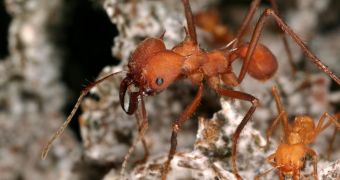Ants generally find their food by foraging on the forest floor. Sometimes they need to travel extensive distances in order to get sufficient supplies for a day, and then they have to repeat the same process the following day. More than 50 million years ago, some ants figured out that growing various fungi inside the tunnels of their nests represents a steady source of nourishment. In very much the same way human populations settled down with the advent of the agriculture, the farming ants evolved by being especially fit to grow plants. But a new study shows that their diets changed too as they evolved.
Following in the footsteps of the original Amazonian ant species that first started farming fungi, more than 200 varieties of ants in South America now do the same thing. Their nests contain special rooms that are laden with white fungal filaments. Specialized ants take good care of this source of food, weeding the fungi on a daily basis, and ensuring that proper ventilation and moisture is maintained in the growth area. Some species also apply fertilizers to their gardens, in a bid to increase production.
Scientists have been curious for a long time to see how these ants and their diets evolved, and finally a team from the Okinawa Institute of Science and Technology, in Japan, decided to take on the difficult task of looking into the ants' genetic history. Led by scientist and evolutionary biologist Alexander Mikheyev, the group looked at the insects' molecular clocks, which are basically collections of mutations that have accumulated over the course of the species' evolution inside very short stretches of DNA. The scientists looked at both the ants and their favorite fungi, ScienceNow reports.
In a new scientific paper, scheduled for publication in the June issue of the respected scientific journal The American Naturalist, the experts highlight the example of leaf-cutter ants. These insects diverged from their common ancestor with other ant species some 12 million years ago, but the variety of fungi they consume today only evolved some 2 to 3 million years ago. The group also found that the rate at which the fungi evolve is significantly different from that of the insects themselves. According to the team's proposal, the ants domesticated the fungi some time ago, and the organism spread across the species, until all traces of the fungi that were cultivated before disappeared.

 14 DAY TRIAL //
14 DAY TRIAL //